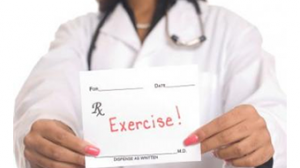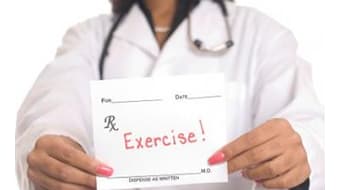
My last column examined the role that exercise can play in reducing and possibly eliminating the need for statins and blood pressure medication. We also discussed the positive effects of exercise for diabetics. This week, we will discuss the benefits of exercise vis-à-vis high blood pressure, high cholesterol and cancer.
High Blood Pressure
High blood pressure, or hypertension, is known as the “silent killer” since the symptoms sometimes do not appear until it is too late. This very treatable condition is prevalent in more than 20 % of the population. Another significant number of people have what is referred to as “high normal” or “borderline” blood pressure – that is, their readings fall slightly above the normal range and as such, they are now at risk for hypertension.
Drugs given for high blood pressure can have multiple side effects and some of them can be very pronounced. Depending upon which drugs you are taking, you may experience any of the following:
- Asthma symptoms
- Cold hands and feet
- Depression
- Insomnia and sleep problems
- A dry, hacking cough that doesn’t go away.
- Skin rash and a loss of taste
- Dizziness
- Constipation
- Dizziness
- Headache
- Irregular or very rapid heartbeat (palpitations)
- Swollen ankles
- Fast heart rate
Exercise can prevent or cure high blood pressure. An inactive person has a 20-50% higher risk of developing high blood pressure than an active person. This statistic is based on studies performed at both Harvard University and the Cooper Institute for Aerobics Research. Even without weight loss, aerobic exercise can lower blood pressure by 10 points or more. And one of the great things about exercising to reduce blood pressure is that one usually starts seeing results after only a few short weeks of starting a program. An added bonus: As exercisers also tend to lose weight and concentrate on diet, results can go far beyond the 10 points mentioned above.
High Cholesterol
Cholesterol is a waxy, fat-like substance found in all animal products. The human body makes cholesterol in the liver and absorbs some of it through diet. It is essential for the body and is used to produce hormones, form bile acids for digestion of fats and to build cell membranes. However, too much cholesterol in the blood can spell trouble in the form of increased risk of coronary heart disease.
Approximately 30% of Americans have high cholesterol. Although drugs are being prescribed today like candy, they have multiple side effects and we are still not 100% sure as to how effective they are in avoiding heart attacks.
Yes they lower your cholesterol, but they also can make you very uncomfortable with muscle pain, they can negatively affect your memory and they may raise your risk of diabetes.
Steps you can take to lower your overall cholesterol, lower your LDL (bad cholesterol) and raise your HDL (good cholesterol) include:
– Exercising
-Losing weight
-Eliminating smoking
-Moderating alcohol consumption
-Eating a healthful diet that includes fruits and vegetables
Even those with hereditary factors can see improvement by adopting the practices listed above.
Cancer
Research has shown that the lifetime risk for developing cancer is 45% in men and 39% in women. However, according to the American Cancer Society, up to two-thirds of cancers are preventable. There is also good news on the cancer treatment front. In the 1930s, fewer than one in five people were alive after five years of treatment for cancer, but today, more than 50% of people getting treatment live five years or more afterwards, and these numbers are expected to continue to improve.
What exactly is cancer? All cancers can be characterized by the uncontrolled growth and spread of abnormal cells. If the spread is not controlled, it can, G-d forbid, be fatal, as vital passageways are blocked and the body’s oxygen and nutrient supplies are diverted to support the rapidly- spreading cancer. Normally, our body cells reproduce and divide in an orderly manner. In that way, old cells are replaced and injured cells are repaired. However, some cells undergo abnormal changes because of oxidants, radiation, viruses, hormones, immune conditions and inherited mutations. It is these abnormal cells that grow into masses called tumors. These tumors can be benign or cancerous.
Interesting to note is that it took the American Heart Association a long time to identify inactivity as a risk factor for heart disease. However, in 1996, the American Cancer Society added regular physical activity to their list of preventive measures. Evidence continues to mount which strongly supports the connection between the development of cancer and inactivity. More current research is showing that:
- Physical activity may lower the risk of cancer by preventing obesity, reducing inflammation and hormone levels, and improving insulin resistance and immune system function.
- Physical activity is associated with a lower risk of several types of cancers, including breast cancer and colon cancer.
Although, we are speaking here of prevention and not curing cancer, cancer experts do encourage moderate exercise during treatment.
Next time, we will look at osteoporosis, metabolic syndrome and lower pack pain.
Alan Freishtat is an A.C.E. CERTIFIED PERSONAL TRAINER and a BEHAVIORAL CHANGE and WELLNESS COACH with over 19 years of professional experience. Alan is the creator and director of the “10 Weeks to Health” program for weight loss. He is available for private coaching sessions, consultations, assessments and personalized workout programs both in his office and by telephone and skype. Alan also lectures and gives seminars and workshops. He can be reached at 02-651-8502 or 050-555-7175, or by email at alan@alanfitness.com Check out the his web site –www.alanfitness.com US Line: 516-568-5027.
The words of this author reflect his/her own opinions and do not necessarily represent the official position of the Orthodox Union.

